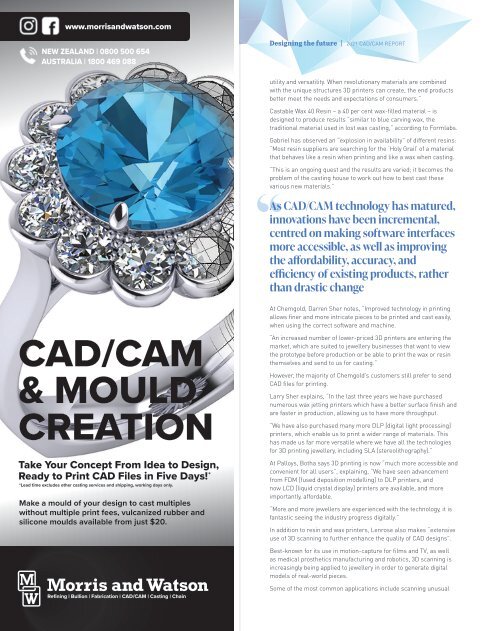Jeweller - June 2021
Create successful ePaper yourself
Turn your PDF publications into a flip-book with our unique Google optimized e-Paper software.
www.morrisandwatson.com<br />
NEW ZEALAND | 0800 500 654<br />
AUSTRALIA | 1800 469 088<br />
Designing the future | <strong>2021</strong> CAD/CAM REPORT<br />
SPOTLIGHT ON<br />
3D SCANNING<br />
<strong>2021</strong> CAD/CAM REPORT | Designing the future<br />
utility and versatility. When revolutionary materials are combined<br />
with the unique structures 3D printers can create, the end products<br />
better meet the needs and expectations of consumers.”<br />
Castable Wax 40 Resin – a 40 per cent wax-filled material – is<br />
designed to produce results “similar to blue carving wax, the<br />
traditional material used in lost wax casting,” according to Formlabs.<br />
Gabriel has observed an “explosion in availability” of different resins:<br />
“Most resin suppliers are searching for the ‘Holy Grail’ of a material<br />
that behaves like a resin when printing and like a wax when casting.<br />
“This is an ongoing quest and the results are varied; it becomes the<br />
problem of the casting house to work out how to best cast these<br />
various new materials.”<br />
One relatively recent innovation in the CAD/CAM sector is 3D<br />
scanning. The scanner creates a digital 3D model of a real-world<br />
object which can then be used as the basis for future designs.<br />
David Gabriel, director Lenrose, explains the process: “We apply a<br />
non-reflective coating to the object that is to be scanned that does not<br />
damage the piece. This allows the scanner to register and scan the<br />
surface. The scanner uses a very soft light source to scan, and there is<br />
no damage at all to jewellery or gemstones.<br />
“In general any piece of jewellery or gemstone can be scanned but as<br />
with every process there are size and geometry limitations.”<br />
Gabriel says preparing pieces for scanning usually takes longer than<br />
the scanning process itself, which he estimates is about 15 to 20<br />
minutes per piece.<br />
Right: Moulds of<br />
wax cast designs.<br />
Below: Computeraided<br />
design in<br />
action. Image<br />
credits: Palloys<br />
As CAD/CAM technology has matured,<br />
innovations have been incremental,<br />
centred on making software interfaces<br />
more accessible, as well as improving<br />
the affordability, accuracy, and<br />
efficiency of existing products, rather<br />
than drastic change<br />
“We started scanning about three years ago,” he continues. “The benefit<br />
to our customers is that we can better produce CAD models to their exact<br />
specifications. Many gemstones have unusual shapes, so we scan the<br />
gems and then produce CAD models that fit the gemstones exactly.”<br />
He adds, “When fitted wedding bands are required it is much easier to<br />
scan the engagement ring and simply CAD the fitted band to suit – you<br />
just know it is going to fit perfectly every time. There are so many varied<br />
applications; it really makes life for everyone so much easier. It has<br />
really been a tremendous advantage to us and allowed us to take on<br />
more complex jobs that otherwise would have been impossible to do.”<br />
At Chemgold, Darren Sher notes, “Improved technology in printing<br />
allows finer and more intricate pieces to be printed and cast easily,<br />
when using the correct software and machine.<br />
CAD/CAM<br />
& MOULD<br />
CREATION<br />
Take Your Concept From Idea to Design,<br />
Ready to Print CAD Files in Five Days!<br />
*<br />
*Lead time excludes other casting services and shipping, working days only.<br />
Make a mould of your design to cast multiples<br />
without multiple print fees, vulcanized rubber and<br />
silicone moulds available from just $20.<br />
Refining | Bullion | Fabrication | CAD/CAM | Casting | Chain<br />
“An increased number of lower-priced 3D printers are entering the<br />
market, which are suited to jewellery businesses that want to view<br />
the prototype before production or be able to print the wax or resin<br />
themselves and send to us for casting.”<br />
However, the majority of Chemgold’s customers still prefer to send<br />
CAD files for printing.<br />
Larry Sher explains, “In the last three years we have purchased<br />
numerous wax jetting printers which have a better surface finish and<br />
are faster in production, allowing us to have more throughput.<br />
“We have also purchased many more DLP [digital light processing]<br />
printers, which enable us to print a wider range of materials. This<br />
has made us far more versatile where we have all the technologies<br />
for 3D printing jewellery, including SLA [stereolithography].”<br />
At Palloys, Botha says 3D printing is now “much more accessible and<br />
convenient for all users”, explaining, “We have seen advancement<br />
from FDM [fused deposition modelling] to DLP printers, and<br />
now LCD [liquid crystal display] printers are available, and more<br />
importantly, affordable.<br />
“More and more jewellers are experienced with the technology, it is<br />
fantastic seeing the industry progress digitally.”<br />
In addition to resin and wax printers, Lenrose also makes “extensive<br />
use of 3D scanning to further enhance the quality of CAD designs”.<br />
Best-known for its use in motion-capture for films and TV, as well<br />
as medical prosthetics manufacturing and robotics, 3D scanning is<br />
increasingly being applied to jewellery in order to generate digital<br />
models of real-world pieces.<br />
Some of the most common applications include scanning unusual<br />
Celebrating 35 Years<br />
Highest Quality Personalised Service<br />
METALS<br />
CASTING<br />
CAD/CAM<br />
REFINING<br />
FINDINGS<br />
1300 984 751<br />
sales@chemgold.com | www.chemgold.com


















